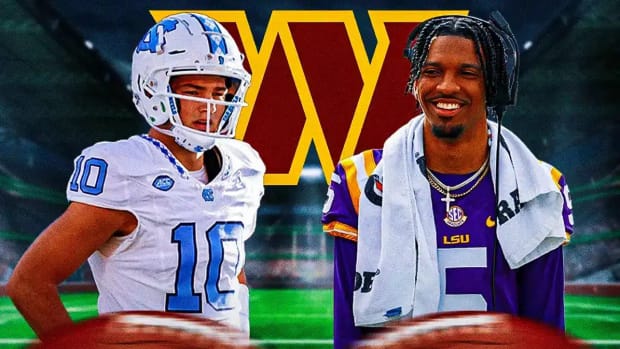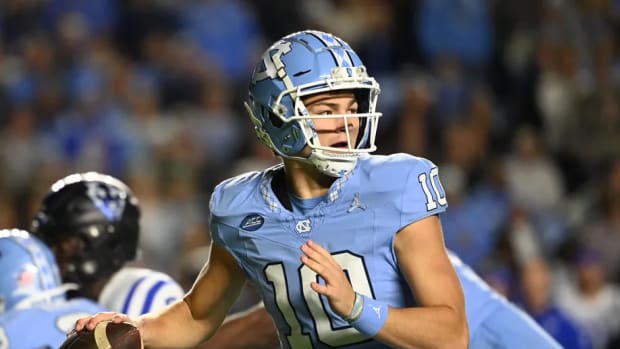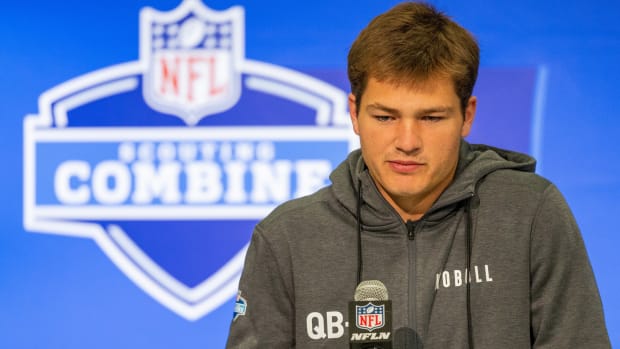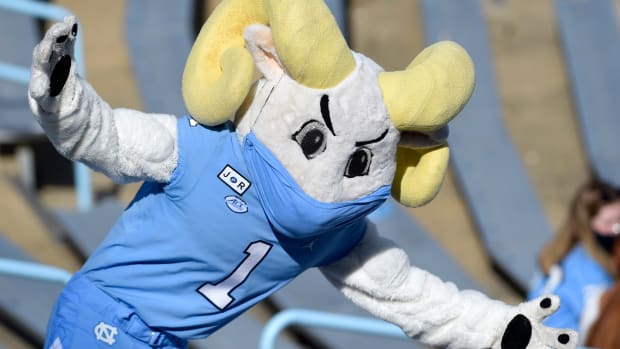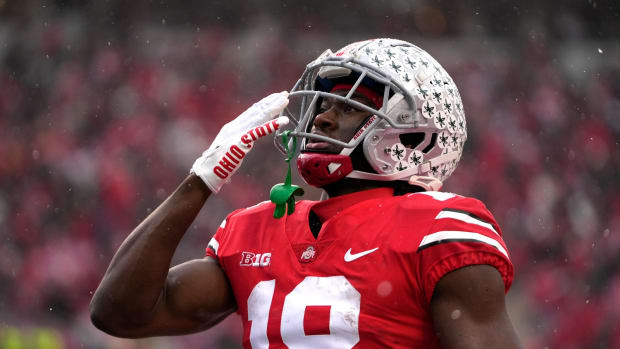Phil Longo Talks Playcalling, Offensive Line Miscues and Sam Howell's Growth
North Carolina offensive coordinator Phil Longo met with the media on Monday to discuss the Tar Heels' loss to Virginia Tech and look ahead to Saturday's matchup with Duke.
Here are the highlights from the conversation:
On the plays he called at the end of regulation
We ran a play that had a designed draw with a throw on it. And the thought process there was, you know, you’ve got to be careful there. Especially in an away game, in my mind, you always want to extend the game as long as you can to give yourself a chance to win. So the last thing that you want to do is put the ball in jeopardy. So you want to be careful, you want to have a good throw, you want to have an easy throw, you want a positive play on first down because we didn’t have a lot of clock. So we called the combo play that gave him the option. Numbers-wise, the draw was there. So that’s, if the throw was there and it was easy and it was a clean throw, he would’ve made that throw and we were trying to get out of bounds and line up to run another one. But that’s the thinking behind the play call, OK?
On the period of time that it takes for an offensive coordinator to understand exactly what the head coach wants in certain situations
Of course there are. It’s something that I try to do, though, in preseason. I don’t want to be learning what the head coach wants in-season. We get the accentuation and we’ve worked them all, we’ve worked them a bunch in camp. Mack and I have a lot of conversations about many, many different situations that will arise in a game. And you want to make sure you get that stuff hammered out before so that we are on the same page on gameday. But I don’t think we’ve had an issue being on the same page at all. I actually enjoy immensely as you well know working for Mack. He lets you coach. And he’ll challenge all of us at the end of the week. We win 40-to-nothing or lose 40-to-nothing, he’s going to challenge anything that he thinks could be better. And it’s good for us as a staff and it’s good for us as the roster because the players and staff are held accountable. We’ve got to get better every week. That’s why you see improvement in our team over the past seven weeks.
On two-point plays this season and specifically the ones that failed at Virginia Tech
Yeah, one, I rolled the dice with the quick pitch and they tracked Michael. I was upset about not getting the facemask call, which was obvious on that. But from a playcalling standpoint, I rolled the dice on it. We didn’t get it. They tracked Michael. You would expect or try to influence it inside. Watching film, he got influenced with run-action going the other way and we thought we’d get the edge kind of like we did earlier this season. I think Miami we ran something similar, not quite the same play. And then the shoot route in the end zone, I don’t know that we ran that well. That was there, we had a 2-for-2. It did not open up. They undercut the route. Sam had to scramble because the route wasn’t there. That was the second 2-point shot.
Explaining a 2-for-2
Well, we had twins, they had three out there but the third one was far inside and it was a nonfactor. And we’re working a chute (shoot?) route or an out route underneath the wideout working inside the corner. We need to push that up a little bit more and rub off the wideout and we didn’t. And he undercut the route. And Sam intelligently didn’t throw that because that wasn’t there. So he had to scramble to the fade by Beau Corrales. That’s what happened on the second one.
How much do you prepare for two-point plays?
Yeah, we work on every situation. You work on 2-point, you work on goal line, you work on third down. It’s on the list and you go through it. I think we carry a couple more now because of the 2-point rule. You don’t really plan to go into five overtimes but you do work them, and if you’re not even going to use them that week, you get to carry them forward when they work against another team, you pull them out of your 2-point library and you put them on the rack for that week. That scenario, like I said, we had something that we emphasize every week. That’s one of them. It’s similar, 2-point plays are real similar to your goal line plays. We used one, the naked, that Toe (Groves) scored on. You second-guess yourself and say, ‘Well heck, should I have used something else to score and held that one for the 2-point?’ But when you’re in the ballgame, touchdowns are important. And we’re calling the very best play that we have on the rack. And you get to a point in five overtimes where you run out of 2-point plays. So that’s kind of where we were.
On the pressure Sam Howell faced up front
Yeah, we cut a few guys loose and didn’t get Sam an opportunity to stick his foot in the ground and make a throw. Early on he did a good job of throwing the ball away and not giving up more sacks in the game. I think we were listed for five. The O-line gave up two really. Three of them were quarterback draws in which Sam got tackled behind the line of scrimmage, which statistically gets counted as a sack, but when we evaluated in the passing game, we gave up two on Saturday from a pass-game standpoint.
His assessment of the offensive line
I think we had some miscues on Saturday that affected us. I don’t think we had the same continuity up front that we did in the Clemson game and in the Georgia Tech game. So those are things we have to get cleaned up here before Duke, because Duke is going to be one of the very best-coached teams that we play this whole season. Without question, I think, on both sides of the football.
On second half rushing issues
Yeah, up front, the mistakes we really didn’t discriminate. We had a couple in pass protection. And we had a couple in the run game that resulted in some TFLs, that were more physical in nature than they were mental. It’s just those little things are things we’ll focus on this week. You can’t make those same mistakes against Duke if you expect to beat this team.
On the loss of Dyami Brown and how it changes the offense
You know, with the return of Antoine Green, it really didn’t. If Antoine wasn’t here, then you’re going with a younger wide receiver, maybe with different attributes. Antoine has the ball ability, Beau has proven to be able to do what he needs to do, we’ve been happy with his play. So you always miss a Dyami Brown, don’t get me wrong. But I thought it was a good time to have Antoine Green back and healthy and 100 percent, because he was able to take those reps that were given to him because of Dyami’s injury. So we expect him to be back and I think the three to the four guys that Lonnie’s been working at wide receiver right now you’ll see on Saturday as well.
On the double-reverse pass to Antoine Green
Coach Brewster has run that before, I have run that before. You have a library of exotics, as we call them, or trick plays. Some games you go into a ballgame and in the game plan you don’t carry any, you don’t feel like you need it. Other games you feel like you do. It’s kind of like the 2-point list. You go to your library of things and you pull out what you think that you have run that’s worked, that you have confidence in. You pull them out and if the team that you’re playing is susceptible to them, you choose a few. That was just one that we had that on the playlist a few weeks ago, did not pull the trigger on it, didn’t need it, didn’t get the scenario that we wanted to call it. So it stays in your bag until you see another opponent like Virginia Tech that we thought it would hit on. We tried to call it when it might—we wanted it to be a big play. I really wanted to call it once we crossed midfield. The tight end also had an opportunity to catch that one, he was the wheel down the sideline. He wound up going to AG, who was the inside vertical. So he was the one that they cut loose so Sam found him. We hit it at a good time, I thought, in the fourth quarter.
On Garrett Walston playing more
I think Garrett, one, Carl, he’s had some nagging injuries. He’s been bothered by some things on and off. That’s giving Garrett Walston an opportunity to get some more reps, and Garrett has been really, really productive. I know Coach Brewster is happy. He’s done a better job being physical in the box. He’s a really, really good receiver out in space. He’s the one that’s been consistently healthy. He’s been practicing real well. Right now he’s the starter and Coach works in Carl behind him.
On Sam Howell's recent progress after two straight big games
I just think, it’s like our third-down percentage has been a lot better the last four weeks than it was at the beginning of the year. And a lot of the important areas offensively are just getting better, systematically and consistently better every week. I think the passing game with Sam is no different. He’s pulling the trigger faster. He’s making faster decisions. For the most part, he’s making good decisions. So he’s not really putting the ball in jeopardy. The other thing I would say with regards to his specific throw talent is he does a great job of putting the ball in safe areas. We don’t have a lot of receivers that make contested catches.
The way the passing game works is we’ve talked about guys are in grass a lot, they’re open. So he’s hitting guys in open space. But when there is a contested catch, meaning a receiver with a defender on him on one side or the other, he does a really, really good job of placing the ball away from the color of the defender. When I first started coaching, when I got into this stuff early on, and coaches talked about, ‘Hey, look we’re going to landmark the ball on this armpit as opposed to this armpit,’ I didn’t buy that. I just thought that was so specific and unrealistic. Quarterbacks are moving, receivers are moving. But it couldn’t be more helpful to our passing game. We say in the quarterback room: ‘Aim small, miss small.’ So there’s a small target we want to find on every receiver. Some guys are better at that than others. Sam is really, really good at putting the ball in an area where we’re not jeopardizing it with the defense.
On Antonio Williams getting back into the running back rotation
The last couple of weeks, he also has had some nagging injuries. So he hasn’t practiced quite as much and he has not been at 100 percent. This was the first game we felt like he was back at 100 percent. The truth be told, I let Coach Gillespie run the rotation with the RBs. He knows that room better than I do. He knows what we’re doing offensively, he knows where they fit. He plays them sometimes by situation, as I told you earlier. A lot of times we play them by who’s hot. He does bring a very physical element to our backfield. We hadn’t used him in short-yardage/goal line. We used him in protection. He did a good job of getting the ball on the perimeter against Virginia Tech. Coach G has a really good feel for that room and we’re going to continue to let him manage those three guys.
